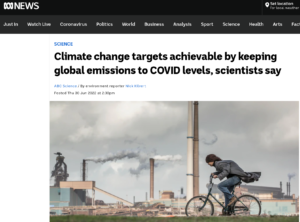Key excerpts:
ABC – Australian Broadcast Company: To keep climate change within limits that we can reasonably adapt to, the world needs to cut emissions at nearly the same rate it did during the peak of the global COVID-19 pandemic, scientists say. According to the international team of scientists, who published their findings in Nature Geoscience.
Climate scientists say driving down emissions by a similar percentage each year, by transforming to a clean energy economy, could keep warming to around 1.5C
The climate emergency needs to be handled with the same urgency as the pandemic, they warn
Between 2019 and 2020, global carbon dioxide emissions experienced the largest single year-on-year decline ever recorded — 6.3 per cent — dwarfing dips during both the global financial crisis of 2008, and the estimated decline following the end of World War II. If we could continue that trend every year, we’d be able to limit warming to around 1.5 degrees Celsius, according to the international team of scientists, who published their findings in Nature Geoscience.
“This tells you that the massive change we saw in the economy — in this case because we were shutting it down — an equivalent change needs to happen in the decarbonisation of the world,” said study co-author Pep Canadell from the CSIRO. “Those equivalent units in the economy that shut down [during COVID], those units need to be switched to the zero carbon economy.”
They found the biggest factor in reducing emissions was the decrease in ground transport — cars and freight — which accounted for just under a third of the cut. Reduced emissions from international aviation, industry and power also featured prominently.
The initial wave of COVID-19 in the first half of 2020, which resulted in broad “stay-at-home orders, closure of factories, collapse of air traffic and perturbations of supply chains”, saw the greatest drop in CO2 production compared to the equivalent period in 2019. For a single week in April, when many regions were under strict lockdowns and industrial and aviation activity was limited, it was estimated that 17 per cent less carbon dioxide emissions were pumped into the atmosphere, compared to the same week the previous year.
The significance of the study, according to climate scientist Nerilie Abram from the Australian National University, is that it demonstrates the world is capable of acting collectively to implement change on the scale that the climate emergency demands. “It’s a great demonstration that it is possible to reduce our emissions, we just need to choose the way we’re going to do that,” Professor Abram said.
“It’s not just individuals doing their part to reduce how much they travel — those sorts of things are not the solutions. “We need a planned transition across society to implement the changes that are needed.”
It’s also important to note that we would need to see this type of reduction in emissions compounded each consecutive year as we drive towards net zero, she said. “It is a really interesting example that shows you what it means when scientists say we need ambitious and immediate action to [combat climate change].”
The problem of course is that in the economic rebound that followed COVID restrictions, emissions have again headed north, Dr Canadell said. “We missed an opportunity and made decisions that weren’t the best for a green recovery.”
To keep climate change within limits that we can reasonably adapt to, the world needsto cut emissions at nearly the same rate it did during the peak of the global COVID–19 pandemic, scientists say.
Key points:
- Relative CO2 emissions dropped more between 2019 and 2020 than at any other time in recorded modern history
- Climate scientists say driving down emissions by a similar percentage each year, by transforming to a clean energy economy, could keep warming to around 1.5C
- The climate emergency needs to be handled with the same urgency as the pandemic, they warn
Between 2019 and 2020, global carbon dioxide emissions experienced the largest single year-on-year decline ever recorded — 6.3 per cent — dwarfing dips during both the global financial crisis of 2008, and the estimated decline following the end of World War II.
If we could continue that trend every year, we’d be able to limit warming to around 1.5 degrees Celsius, according to the international team of scientists, who published their findings today in Nature Geoscience.
“This tells you that the massive change we saw in the economy — in this case because we were shutting it down — an equivalent change needs to happen in the decarbonisation of the world,” said study co-author Pep Canadellfrom the CSIRO.
“Those equivalent units in the economy that shut down [during COVID], those units need to be switched to the zero carbon economy.”
While the economy contracted markedly during 2020, that does not need to be the case in order to reduce global emissions, Dr Canadell said.
“The economy is so [intertwined] with fossil fuels, that when the economy collapses, so do emissions,” he said.
Under the 2015 Paris Agreement, signatory countries pledged to limit global temperature increase this century to below 2C, and to pursue efforts to limit warming to 1.5C.



